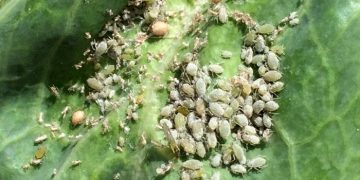#gardening #farming #pestcontrol #cabbage #aphids #IPM #naturalpredators
Cabbage aphids, scientifically known as Brevicoryne brassicae, are small insects that can cause significant damage to cabbage plants. They feed on the sap of the plant, causing it to wilt and ultimately die. If you’re a gardener or farmer who grows cabbage plants, it’s essential to understand the development and consequences of cabbage aphid infestations.
Brevicoryne brassicae typically attacks cabbage plants during the cooler months of the year. Female aphids give birth to live young, and these offspring quickly mature and begin to reproduce, leading to a rapid increase in population size. The aphids also produce a sticky substance known as honeydew, which attracts ants and can cause mold to develop on the plant.
Fortunately, there are several measures that can be taken to protect cabbage plants from Brevicoryne brassicae. One of the most effective methods is to introduce natural predators, such as ladybugs, lacewings, and parasitic wasps, which can help to control the aphid population. Additionally, using insecticidal soaps and oils, as well as maintaining proper plant hygiene, can help to prevent and control infestations.
However, it’s important to note that overuse of pesticides can harm beneficial insects and lead to the development of resistant strains of cabbage aphids. Therefore, it’s crucial to practice integrated pest management (IPM) techniques, which involve a combination of preventive measures and targeted pesticide use.
Understanding the biology and behavior of Brevicoryne brassicae and implementing proper management techniques is crucial for protecting cabbage plants from these destructive insects. By taking a proactive approach and using natural predators and IPM techniques, gardeners and farmers can effectively control cabbage aphid populations and ensure the health and vitality of their crops.


































